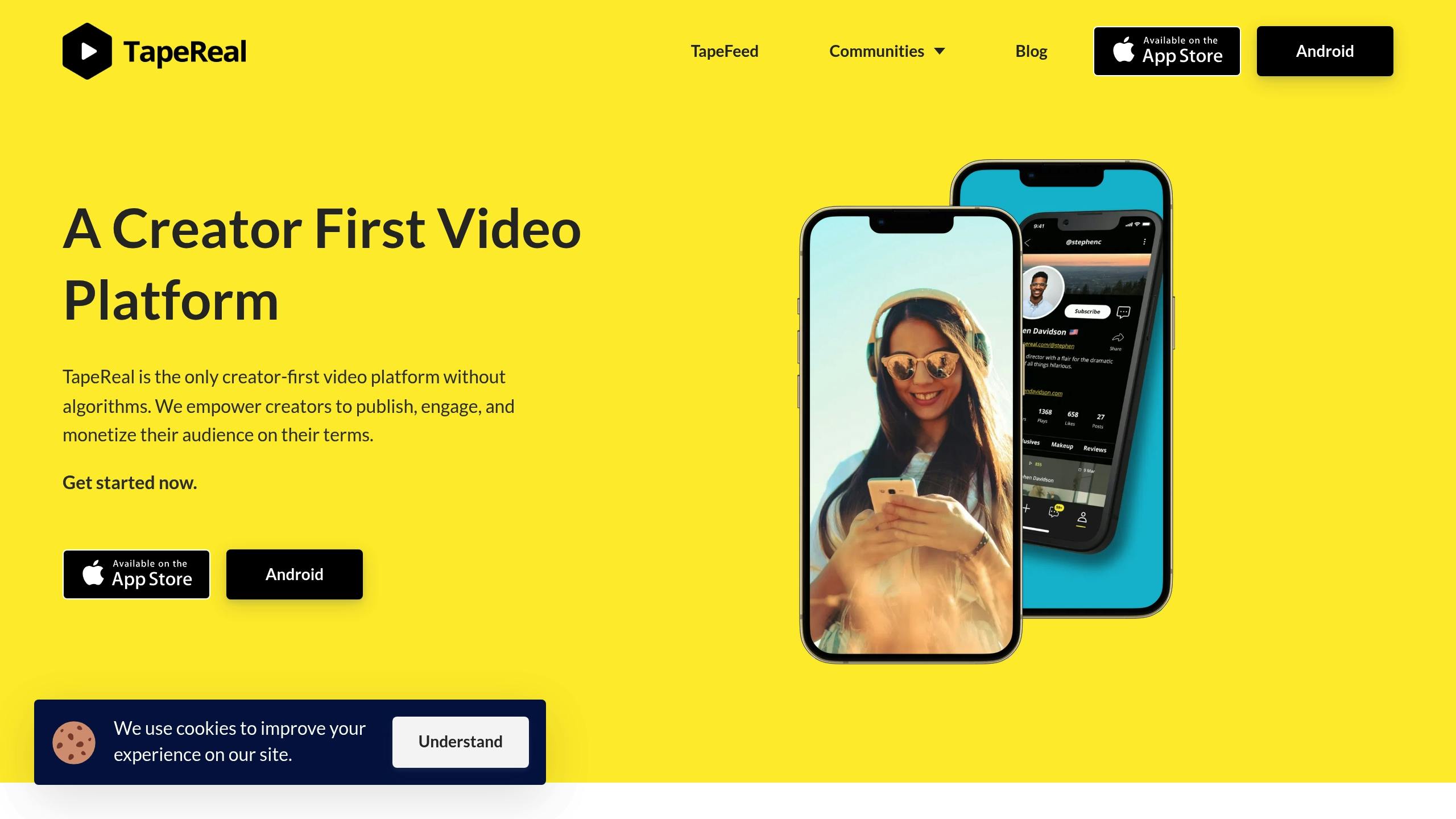YouTube creators make money through diverse streams, including ads, memberships, live donations, brand deals, and affiliate marketing. Here's a quick breakdown:
- Ad Revenue: Earn 55% of ad income, with RPMs ranging from $1-$8 depending on ad type.
- Memberships: Offer perks like badges, exclusive posts, or live Q&As, with tiers from $4.99 to $19.99.
- Live Donations: Use Super Chats and Stickers during streams, with average donations between $0.50-$20.
- Merchandise: Sell products via YouTube Stores, which see 23% higher conversion rates.
- Brand Deals: Sponsorship rates vary by channel size, from $500 to $10,000+ per video.
- Affiliate Marketing: Promote niche products for commissions (4%-45%), depending on the program.
To start earning, you need to join the YouTube Partner Program by meeting subscriber and view thresholds. Successful creators combine multiple revenue streams and focus on audience engagement to grow their income.
YouTube Monetization Explained
Main YouTube Income Sources
YouTube creators can tap into several revenue streams directly through the platform. Here's a breakdown of the main ways to earn and how to make the most of each option.
Ad Revenue and Partner Program
Ad revenue is a major source of income for YouTubers, with creators earning 55% of the ad revenue generated by their videos [7]. The secret to boosting these earnings lies in smart content planning and ad placement.
| Ad Type | Typical RPM Range | Tips for Optimization |
|---|---|---|
| Pre-roll | $2-5 per 1000 views | Place key content after the first 30 seconds |
| Mid-roll | $4-8 per 1000 views | Add ad breaks every 8-10 minutes |
| Display | $1-3 per 1000 views | Use eye-catching thumbnails and compelling titles |
To maximize ad revenue, consider creating videos longer than 8 minutes, as this allows for multiple mid-roll ad placements. Additionally, YouTube Premium subscribers contribute revenue based on how much time they spend watching your content [5].
Member Subscriptions
Channel memberships are becoming a popular way to earn, with some creators pulling in up to 22% of their total income from this feature [5]. The key to success is offering well-structured membership tiers.
"Smart Passive Income channel demonstrates the power of membership tiers, generating significant revenue through weekly member-only coaching sessions" [5].
Here’s a common tier structure that works well:
| Tier Level | Price Point | Perks |
|---|---|---|
| Entry | $4.99 | Custom badges and emojis |
| Mid-tier | $9.99 | Exclusive posts and community polls |
| Premium | $19.99 | Monthly Q&A sessions and private live streams |
The more value you offer at each level, the more likely viewers are to subscribe and stay loyal.
Live Stream Donations
Super Chats and Super Stickers enable creators to earn directly during live streams. Educational and coaching streams tend to see higher donation averages ($5-$20) compared to gaming streams ($0.50-$2) [5].
To boost Super Chat earnings:
- Plan specific moments during the stream to acknowledge donors.
- Use animated alerts to make donations stand out.
- Engage directly with donors through shout-outs or answering their questions in real time.
YouTube Store Integration
Integrating a store with your channel can drive conversions, with a 23% higher conversion rate compared to external links. The average order value through YouTube stores is $35 [3][5].
To get the best results:
- Use vertical product images (1200x1600px) for better visibility.
- Highlight products in your video end screens.
- Focus on a curated selection of 12 core items.
- Offer exclusive merch for your YouTube audience.
Working with Brands
Beyond YouTube's built-in features, creators can expand their income streams by partnering with brands. While YouTube stores focus on physical products, brand deals capitalize on audience trust through endorsements.
Sponsored Content
To land profitable sponsorships, you need to understand what makes your channel valuable. For example, tech and finance creators generally earn 30% higher rates than lifestyle-focused channels [5]. Here’s a breakdown of typical rates based on channel size:
| Channel Size | Typical Rate Range | Content Type |
|---|---|---|
| 10K-50K subscribers | $500-1,500 per video | Product mentions |
| 50K-100K subscribers | $1,500-3,000 per video | Detailed showcases |
| 100K+ subscribers | $3,000-10,000+ per video | Dedicated content |
Make sure to follow FTC guidelines by including verbal or written disclosures within the first 30 seconds of your video [4][6].
"The most successful sponsorship disclosures combine YouTube's paid promotion label with clear verbal statements at the start of the video. This transparency actually builds trust and increases conversion rates for brand partners" [4].
Affiliate Marketing
Affiliate marketing is another way to earn recurring revenue alongside sponsorships. Success depends on matching the right affiliate programs with your content niche. Here are some examples:
| Content Niche | Top Performing Programs | Average Commission |
|---|---|---|
| Technology | Amazon Associates, ShareASale | 4-8% |
| Beauty/Fashion | Sephora Affiliates, Rakuten | 5-15% |
| Education | Coursera, Skillshare | 20-45% |
To make the most of affiliate marketing:
- Personally test products before promoting them.
- Use unique tracking links for different video placements.
- Add clear #Ad disclosures in titles and descriptions [4][6].
- Focus on products that already perform well in your niche.
sbb-itb-bc761f5
External Platform Income
Once creators establish brand partnerships, they can boost their earnings by leveraging third-party platforms that offer better revenue shares and more control over their content.
TapeReal: Sell Premium Content

TapeReal lets creators sell exclusive video content without worrying about visibility restrictions. Here's how it compares to YouTube:
| Feature | TapeReal | YouTube |
|---|---|---|
| Revenue Share | 90% | 55% |
| Pricing Control | Custom tiers | Fixed rates |
| Content Type | Exclusive series | Standard uploads |
For example, tech reviewers might sell benchmark data bundles, while educators can offer in-depth tutorials. The key is to create content that complements YouTube uploads rather than replicating them.
"The most successful creators use YouTube videos as teasers for in-depth tutorials on member platforms, following YouTube's content guidelines while maximizing revenue potential" [9].
Membership Platforms for Subscriptions
Membership platforms allow creators to set up subscription models that work alongside their YouTube income. Here's a quick comparison:
| Platform | Creator Revenue | Minimum Payout | Key Features |
|---|---|---|---|
| YouTube Members | 70% | $100 | Single tier ($4.99) |
This approach reflects the multi-income strategy often seen in brand partnerships. For instance, the educational channel Kurzgesagt generates 60% of its revenue through external memberships [5].
To make the most of these platforms, creators should:
- Use trackable links in video descriptions [8]
- Add mid-roll calls-to-action for exclusive content
- Highlight memberships in end screen promotions [9]
These tactics align with the broader strategy of diversifying income streams for long-term growth.
Income Growth Tactics
Top YouTube creators maximize their earnings by combining multiple revenue streams and focusing on audience engagement. According to data, creators using three or more income sources see 58% steadier monthly earnings compared to those relying on just one [5].
Combining Income Sources
Layering different monetization strategies based on engagement levels can yield better results:
| Stream | Timing | Impact |
|---|---|---|
| Channel Memberships | 30K+ subscribers | 3-5% conversion rate [1] |
Creators often pair YouTube's tools with external platforms like TapeReal to build a well-rounded revenue system. Many successful creators introduce new income streams every 3-6 months [1]. This gradual rollout helps maintain audience trust while growing revenue over time.
Viewer Engagement Methods
Audience engagement plays a critical role in increasing monetization rates across all revenue streams. YouTube's algorithm now prioritizes audience retention patterns over total views, as outlined in the Partner Program guidelines [2][6]. Leading creators focus on maintaining high audience retention:
"The most successful channels maintain a 60%+ average view duration, triggering higher ad rates and improving membership conversion rates across the board" [6].
To boost engagement while optimizing monetization, creators often:
- Include recurring video segments to align with algorithm preferences
- Add closed captions in their top three viewer languages
- Limit calls-to-action to 2-3 per video to avoid overwhelming viewers [3]
For example, beauty creators who adopted these strategies saw their RPM increase from $3 to $8 [5]. Transparency with the audience remains a crucial part of this process.
During Q4, many creators focus on seasonal strategies like gift guide affiliate compilations, which have been shown to boost click-through rates by over 50% [9][5].
Conclusion
Earning a steady income on YouTube involves using a mix of the platform's features and external tools. Top creators often rely on at least three revenue streams, combining YouTube's built-in options with carefully chosen outside platforms.
Start with YouTube's own tools - like the Partner Program and memberships - and gradually add external platforms as your audience grows. This layered approach offers both stability and room for growth.
Studies show that full-time creators see the best results when they:
- Make the most of the YouTube Partner Program
- Introduce channel memberships after building a solid audience
- Expand to other platforms that complement their content
- Focus on keeping audience retention rates high
It’s important to track your income sources and sponsorship rates regularly to ensure growth across all streams [10]. By blending strategies like ad optimization and platform partnerships, creators can develop a more reliable income.
Be transparent with your audience as you explore new revenue options. This helps maintain trust while building a scalable income model that grows alongside your channel.
FAQs
How many views do you need on YouTube to make $1,000 a month?
To earn $1,000 per month on YouTube, you'll typically need anywhere from 125,000 to 500,000 views, depending on your niche and where your audience is located. Here's a breakdown based on content type:
| Content Type | Estimated Views Needed |
|---|---|
| Finance/Tech | 125,000 - 200,000 |
| Gaming | 330,000 - 500,000 |
| General Content | 200,000 - 400,000 |
Your actual earnings depend on several factors, including:
- Audience Location: Viewers in regions like the US or Canada often generate higher RPMs ($3-$12) compared to those in lower-income areas.
- Viewer Retention Rates: Channels with retention rates above 60% can earn significantly more - sometimes up to three times as much.
- Seasonal Trends: Ad rates tend to spike during the last quarter of the year, particularly from October to December.
To boost your earnings:
- Use the niche selection tips from the Brand Partnerships section.
- Focus on attracting viewers from regions with higher ad rates.
- Pair these efforts with retention strategies from the Growth section.
The key to success is combining these strategies while keeping your audience engaged and maintaining high retention rates.

